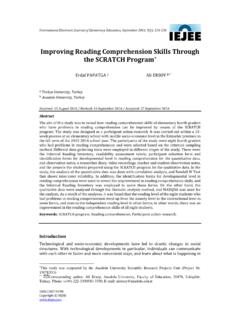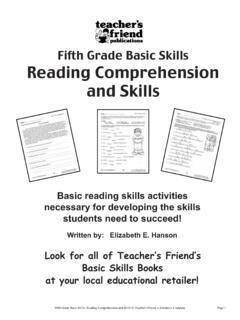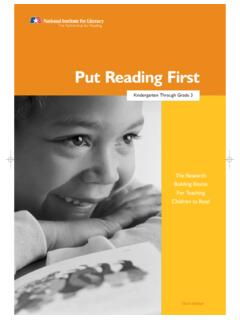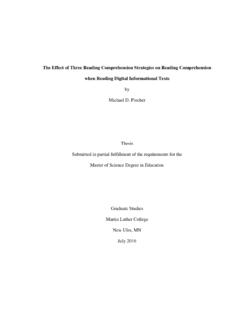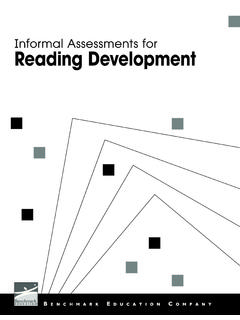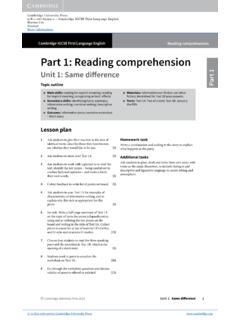Transcription of Improving Reading Comprehension - ed
1 Improving Reading Comprehension . THROUGH HIGHER-ORDER THINKING skills . Brigitte A. McKown, Cynthia L. Barnett, A Research Project Submitted to the Graduate Faculty of the School of Education in Partial Fulfillment of the Requirements for the Degree of Master of Arts Saint Xavier University Chicago, Illinois May 2007. i ABSTRACT. This action research project was conducted to improve Reading Comprehension with second grade and third grade students. The teacher researchers intended to improve Reading Comprehension by using higher-order thinking skills such as predicting, making connections, visualizing, inferring, questioning, and summarizing.
2 In their classrooms the teacher researchers modeled these strategies through the think-aloud process and graphic organizers. This was followed by students using these strategies through whole class, small group, and independent practice. The teacher researchers gathered information prior to implementing the Reading strategy interventions. The Metacomprehension Strategy Index indicated a lack of student knowledge of strategies to use before, during, and after Reading . The State Snapshot of Early Literacy given to the second grade students identified 9 of the 16 students below target level.
3 The Test Ready Test given to the third grade students indicated 10 of the 17 students were at risk for Reading Comprehension failure. The information gathered by the teacher researchers after the interventions had been modeled and practiced showed improvement with the second and third grade students. The post- intervention scores for the Metacomprehension Strategy Index showed a significant increase in students' knowledge of the Reading Comprehension strategies. The State Snapshot of Early Literacy post-intervention scores indicated only 6 of the 16 second grade students remained below target level for Reading Comprehension .
4 The Test Ready Test given to third grade students indicated only 2 of the 16 students had post-intervention scores that were at risk for Reading Comprehension failure. ii TABLE OF CONTENTS. ABSTRACT ..i CHAPTER 1-PROBLEM STATEMENT AND CONTEXT 1. General Statement 1. Immediate Problem Context 1. Surrounding Community .3. National Context of the Problem .3. Reflection .4. CHAPTER 2-PROBLEM DOCUMENTATION 6. Problem Evidence 6. Probable Causes .12. CHAPTER 3-THE SOLUTION STRATEGIES ..17. Literature Review ..17. Project Objectives and Processes ..20. Project Action Plan 21. Methods of Assessment.
5 26. CHAPTER 4-PROJECT RESULTS ..28. Historical Description of the Interventions 28. Presentation and Analysis of Results .28. Conclusion and Recommendations 34. Reflection ..35. REFERENCES ..39. APPENDICES ..41. iii Appendix A 42. Appendix B 46. Appendix C 53. CHAPTER 1. PROBLEM STATEMENT AND CONTEXT. General Statement of the Problem In this study the target groups were students in a second grade classroom and students in a third grade classroom. The teacher researchers have seen children experience difficulty with the process of Reading Comprehension , which causes them great concern as educators.
6 The researchers feel more time is typically spent teaching students how to do the worksheets, instead of teaching Reading strategies to improve Reading Comprehension . Through the teacher researchers' observations and students' written responses on Comprehension worksheets, evidence has been found that their students struggled to derive meaning from the text they have read. Immediate Problem Context This research project was conducted at one site, an elementary school, with a population of 493 students, (Interactive State Report Card, 2005). The school consisted of Caucasian, Hispanic, African American, Native American, Asian as reported by the 2005 State District Report Card (SDRC).
7 The 2005 SDRC reported that of the students were eligible to receive free or reduced-price lunches based on the number of families receiving public aid at the school. There were no students at the school with English as a second language and there were 52% male and 48% female students in the school's student body (SDRC, 2005). 2. The teachers at the school had an average of years of experience, with having a bachelor's degree and having a master's degree and above, as stated in the 2005 SDRC. The teaching staff at the school was 100% Caucasian with male and female. The school had an average class size of at the kindergarten level, at the first grade level, and at the third grade level.
8 The pupil to teacher ratio was 16:7 at the school (SDRC, 2005). The administrative staff at the school consisted of one superintendent and one principal. The teaching staff at this school consisted of 25 full-time classroom teachers, four special education teachers, three Title I Reading teachers, one art teacher, one physical education teacher, and one music teacher. The support staff consisted of several office workers, two kindergarten aides, two computer technicians, one librarian, six special education assistants, kitchen, and custodial staff. The teacher researchers feel that Reading Comprehension is the basis for how students perform in all subjects.
9 The third grade students at the school scored on Reading , on math according to the 2004-2005 SSAT (SDRC, 2005). Students in Grade 4 scored 90% in Science on the 2004-2005 SSAT. Students in Grade 5 scored in Reading , and in math on the 2004-2005 SSAT according to the State District Report Card. The researchers found the drop in Reading scores from third to fifth grade significant. Each year the school board and administration required the teachers at the school to develop a school improvement plan that included Level I, Level II, and Level III. At Level I teachers were to develop an individualized plan using available data, such as SSAT and Scholastic Testing Services Achievement Test scores and/or classroom observations, to address a student's strengths or weaknesses.
10 3. For Level II, teachers at each grade level were to use available data to develop grade level goals to improve class deficiencies or accelerate strengths. Individual teachers were to develop Level III goals for self-improvement or curriculum improvement in their classrooms. Surrounding Community The school is located in a suburban village community in a Midwestern state. According to the 2000 Census Bureau, the population of this village is about 6,154 people, with a Caucasian population. The average income is around $40 thousand per year, per family. According to the Census Bureau, the average household is persons.










